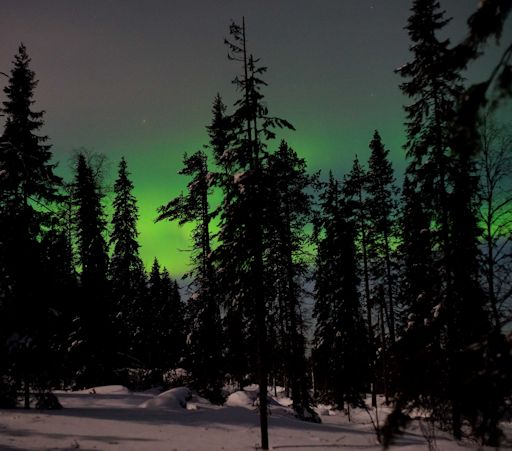JUPITER AND THE MOON: When the sun goes down tonight, step outside and look east. The waxing full Moon is approaching Jupiter for a close encounter on Jan. 14th. The two brightest objects in the evening sky are easy to see even from urban areas with strong light pollution. Backyard astronomy alerts: text, voice.
FAST SOLAR WIND: Blowing with gusts as fast as 800 km/s (1.8 million mph), a stream of solar wind is buffeting Earth's magnetic field. Because the density of the stream is so low, it is not causing strong geomagnetic storms. Nevertheless, some bright auroras have appeared around the Arctic Circle:
Asko Aikkila sends this picture from Kuusamo, Finland. "Last night when I was going to sleep, I looked through the bedroom window and saw silent auroras dancing in the moon light. I snapped the picture right through the window. It was a very pleasant way to experience the Northern Lights."
Arctic sky watchers should remain alert for auroras on Jan. 13-14 as the solar wind continues to blow. Aurora alerts: text, voice.

Solar wind
speed: 649.9 km/sec
density: 0.5 protons/cm3
explanation | more data
Updated: Today at 1847 UT
X-ray Solar Flares
6-hr max: C1 1633 UT Jan13
24-hr: C1 1633 UT Jan13
explanation | more data
Updated: Today at: 1800 UT
![]()
Daily Sun: 13 Jan 14
Decaying and departing, sunspot AR1944 has a 'beta-gamma' magnetic field that harbors energy for M-class solar flares. Credit: SDO/HMI
![]()
Sunspot number: 118
What is the sunspot number?
Updated 13 Jan 2014
Spotless Days
Current Stretch: 0 days
2014 total: 0 days (0%)
2013 total: 0 days (0%)
2012 total: 0 days (0%)
2011 total: 2 days (<1%)
2010 total: 51 days (14%)
2009 total: 260 days (71%)
Update 13 Jan 2014
The Radio Sun
10.7 cm flux: 155 sfu
explanation | more data
Updated 13 Jan 2014
![]()
Current Auroral Oval:
Switch to: Europe, USA, New Zealand, Antarctica
Credit: NOAA/POES
![]()
Planetary K-index
Now: Kp= 1 quiet
24-hr max: Kp= 4 unsettled
explanation | more data
Interplanetary Mag. Field
Btotal: 6.5 nT
Bz: 2.0 nT north
explanation | more data
Updated: Today at 1847 UT
![]()
Coronal Holes: 13 Jan 14
Earth is inside a stream of solar wind flowing from the indicated coronal hole. Credit: SDO/AIA.





